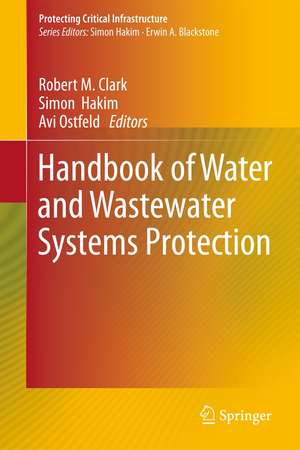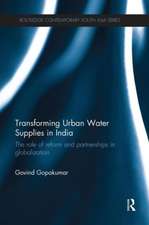Handbook of Water and Wastewater Systems Protection: Protecting Critical Infrastructure
Editat de Robert M. Clark, Simon Hakim, Avi Ostfelden Limba Engleză Paperback – 27 oct 2013
| Toate formatele și edițiile | Preț | Express |
|---|---|---|
| Paperback (1) | 1228.47 lei 43-57 zile | |
| Springer – 27 oct 2013 | 1228.47 lei 43-57 zile | |
| Hardback (1) | 1228.62 lei 43-57 zile | |
| Springer – 31 aug 2011 | 1228.62 lei 43-57 zile |
Preț: 1228.47 lei
Preț vechi: 1498.13 lei
-18% Nou
Puncte Express: 1843
Preț estimativ în valută:
235.06€ • 246.09$ • 194.50£
235.06€ • 246.09$ • 194.50£
Carte tipărită la comandă
Livrare economică 07-21 aprilie
Preluare comenzi: 021 569.72.76
Specificații
ISBN-13: 9781461429845
ISBN-10: 1461429846
Pagini: 544
Ilustrații: XVI, 528 p.
Dimensiuni: 155 x 235 x 29 mm
Greutate: 0.75 kg
Ediția:2012
Editura: Springer
Colecția Springer
Seria Protecting Critical Infrastructure
Locul publicării:New York, NY, United States
ISBN-10: 1461429846
Pagini: 544
Ilustrații: XVI, 528 p.
Dimensiuni: 155 x 235 x 29 mm
Greutate: 0.75 kg
Ediția:2012
Editura: Springer
Colecția Springer
Seria Protecting Critical Infrastructure
Locul publicării:New York, NY, United States
Public țintă
ResearchTextul de pe ultima copertă
Following the events of 9/11, the Administrator of the US Environmental Protection Agency created the Water Protection Task Force (WPTF), which identified water and wastewater systems as a major area of vulnerability to deliberate attack. The WPTF suggested that there are steps that can be taken to reduce these vulnerabilities and to make it as difficult as possible for potential saboteurs to succeed. The WPTF recommended that be scrutinized with renewed vigor to secure water and wastewater systems against these possible threats. It also recommended that water and wastewater systems have a response plan in place in the event an act of terrorism occurs. The WPTF identified water distribution networks as an area of special vulnerability and highlighted the need for rapid on-line detection methods that are accurate and have a wide detection range. As a result of these recommendations novel technologies from various fields of science and engineering are now addressing water security issues and water and wastewater utilities are looking for innovative solutions. Once such technologies are available, there will be a rapid implementation process that will present many business opportunities for the private sector. However, in addition to terrorist threats water and wastewater systems are inherently vulnerable to natural disasters such as earthquakes and floods. This volume will address the problems associated with both intended terrorist attacks and natural disasters affecting water or wastewater systems. The book is divided into parts based on the kinds of threats facing water and wastewater systems: (1) a direct attack on water and wastewater infrastructure storage reservoirs, and distribution and collection networks; (2) a cyber attack disabling the functionality of the water and wastewater systems or taking over control of key components which might result in system failures; and (3) a deliberate chemical or biological contaminant injection at one of the waterdistribution system’s nodes. It will examine unique plans, technological and managerial innovations for protecting such systems, and includes descriptions of projects that were implemented to respond to natural disasters. Case studies are presented that discuss existing projects and evaluate their performance, with an emphasis on providing guidelines and techniques that can be implemented by water and wastewater planners and managers to deal with natural and manmade disasters should they occur.
Caracteristici
Provides implementation guidelines for protecting the water and wastewater supply. Presents strategies to deal with and minimize the effect of possible attacks. Offers the latest thinking and information by a variety of experts from academia, consulting firms, and government Includes supplementary material: sn.pub/extras



















